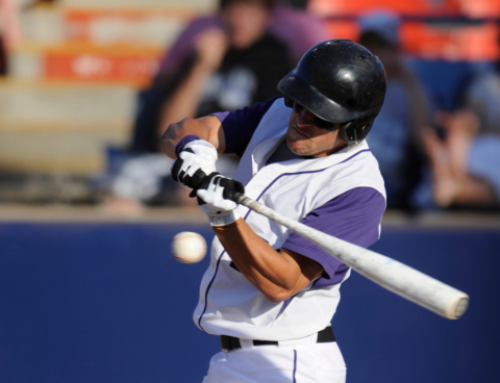Indoor Baseball Infield Drills to Help You Dominate
If you live in an area where winter forces baseball practice inside, you need quality indoor drills to improve as a player and infielder.
When I coached two of the top junior college programs in the country—one in Illinois and the other in Kentucky—we had only a very small indoor practice area. We played our first game in February, so we had to find creative ways to get our players ready.
Here are some of the drills I found to work well for our players.
Wall Ball
Kids love this game. It’s fun, but also quite effective. Players throw the ball against a wall from about 10 to 15 feet away. If someone touches the ball but does not field it cleanly, he must sprint to the wall and touch it before someone else throws the ball and hits the wall.
If the player who bobbled the ball cannot touch the wall before the next throw hits the wall, he has an out. After three outs, a player must sit. If you want more action, don’t worry about outs and let players stay in the game.
This game is very fast if played correctly. It works on quick reactions, soft hands, throwing and athletic ability.
This game works well with three to five players. If you have more than five, create a different game. Use a tennis ball and bare hands, not a glove.
Pre-Prep Drills
We ran these drills every day, and they had an immediate impact. They only take five to seven minutes. These drills improve focus on fundamentals and teach muscle memory.
Knee drills. Without a glove, sit up straight on both knees about 5 to 7 feet away from a partner. Roll the ball directly to the middle of your partner’s body. The fielders work on having their fingers down, their wrists loose and bringing the ball up quickly to the throwing area of the shoulder.
Progress to rolling the ball to the forehand side and then the backhand side. Keep the focus on loose hands and being athletic.
Standing drills. Do the same as the Knee Drills, but while standing. Back up to about 15 feet away from each other. Focus on footwork, staying low, holding your glove out, and keeping your head down on the ball while fielding. The focus should be on footwork and quickly getting into a good position to throw.
Quick Exchange Throwing. If you have enough room to throw, work on quick exchanges. Get the ball out of your glove as quickly as possible and get into a good throwing position, with your shoulders squared toward the target. Relax and set up for a normal throw. Focus on getting the ball out of your glove quickly and squaring your body to the target, not throwing back quickly. This helps with relays and turning double plays.
4-Corner Flips. Have four infielders stand in a square about 5 to 7 feet away from each other. Roll a ground ball to the fielder directly across from you. He fields it and flips the ball underhand to the player to his left.
Good footwork is integral to performing these drills. It will allow your players to field the ball consistently and make quality throws.
Read more:
RECOMMENDED FOR YOU
MOST POPULAR
Indoor Baseball Infield Drills to Help You Dominate
If you live in an area where winter forces baseball practice inside, you need quality indoor drills to improve as a player and infielder.
When I coached two of the top junior college programs in the country—one in Illinois and the other in Kentucky—we had only a very small indoor practice area. We played our first game in February, so we had to find creative ways to get our players ready.
Here are some of the drills I found to work well for our players.
Wall Ball
Kids love this game. It’s fun, but also quite effective. Players throw the ball against a wall from about 10 to 15 feet away. If someone touches the ball but does not field it cleanly, he must sprint to the wall and touch it before someone else throws the ball and hits the wall.
If the player who bobbled the ball cannot touch the wall before the next throw hits the wall, he has an out. After three outs, a player must sit. If you want more action, don’t worry about outs and let players stay in the game.
This game is very fast if played correctly. It works on quick reactions, soft hands, throwing and athletic ability.
This game works well with three to five players. If you have more than five, create a different game. Use a tennis ball and bare hands, not a glove.
Pre-Prep Drills
We ran these drills every day, and they had an immediate impact. They only take five to seven minutes. These drills improve focus on fundamentals and teach muscle memory.
Knee drills. Without a glove, sit up straight on both knees about 5 to 7 feet away from a partner. Roll the ball directly to the middle of your partner’s body. The fielders work on having their fingers down, their wrists loose and bringing the ball up quickly to the throwing area of the shoulder.
Progress to rolling the ball to the forehand side and then the backhand side. Keep the focus on loose hands and being athletic.
Standing drills. Do the same as the Knee Drills, but while standing. Back up to about 15 feet away from each other. Focus on footwork, staying low, holding your glove out, and keeping your head down on the ball while fielding. The focus should be on footwork and quickly getting into a good position to throw.
Quick Exchange Throwing. If you have enough room to throw, work on quick exchanges. Get the ball out of your glove as quickly as possible and get into a good throwing position, with your shoulders squared toward the target. Relax and set up for a normal throw. Focus on getting the ball out of your glove quickly and squaring your body to the target, not throwing back quickly. This helps with relays and turning double plays.
4-Corner Flips. Have four infielders stand in a square about 5 to 7 feet away from each other. Roll a ground ball to the fielder directly across from you. He fields it and flips the ball underhand to the player to his left.
Good footwork is integral to performing these drills. It will allow your players to field the ball consistently and make quality throws.
Read more:










